
What is the problem?
Many Ukrainians, forced to leave their cities and villages because of Russia's large-scale invasion, urgently needed shelter. The government cannot provide social housing for every family, so displaced people must find solutions independently. Over the past two years, the demand for long-term rental housing has only increased. Currently, any available housing — from elite apartments and houses to old or long-abandoned cottages — is being rented out in relatively peaceful regions of Ukraine.
Cheap housing, which often looks unattractive and needs repairs, is unfortunately the only choice for many internally displaced persons (IDPs) because it is the most affordable option for those who have lost everything.
What is the solution?
"For people whose homes were taken by the war, it's important not just to have a roof over their heads but for their new place to feel cozy. There should be something warm, homey, and familiar that gives them energy and strength," says Yulia Dudysheva, a kind-hearted woman living in Ukraine's northern Chernihiv region.
She launched the "Cozy Homes for IDPs" project in Sosnytsia, a town 90 km from the Russian border. Yulia personally renovates homes for displaced people, turning abandoned houses into comfortable and cozy places to live.
How does it work?
"I'm not a designer, decorator, or builder. But I can do a little bit of everything"
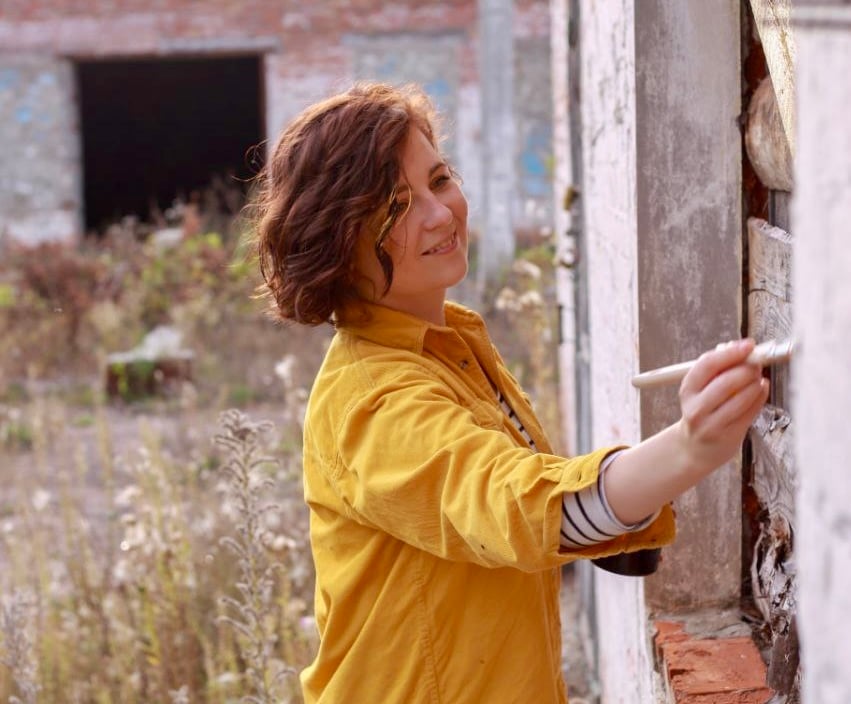
Yulia Dudysheva. Photo from the heroine's archive
Yulia understands from her experience how important a cozy home is for people who lost their homes due to the war or had to move far from their native cities. When Russia occupied Crimea in 2014, she was displaced herself, moving from the peninsula to the Chernihiv region.
Yulia started doing DIYs because she had been interested in redesigning interiors and old furniture since childhood. Her love for change and creating coziness "from nothing" began in the difficult 1990s after Ukraine regained its independence and wasn't standing firm on its two feet.
"We re-wallpapered, sewed new curtains, and came up with design elements," Yulia recalls her family's DIY projects. "My mom let me realize any of my creative initiatives, even painting on the walls. Our house wasn't new but big: four rooms plus a kitchen, hallway, and bathroom, and we gradually improved it all. The renovation was never-ending."
Since then, she has been passionate about this work.
"You know, it's addictive. It hooks you," Yulia laughs. "You can't live without renovations because you're used to doing something every summer. No, it didn't become my profession; it's more of a hobby. It's a passion — to make something with your own hands. I am not a designer, decorator, or builder. But I can do a little bit of everything."
Turning walls into a home
After the Chernihiv region was liberated in early April 2022 after a one-month-long Russian occupation, displaced people began arriving in Sosnytsia, fleeing the fighting in other areas of Ukraine. Yulia decided to help her displaced friends settle into their rented homes.
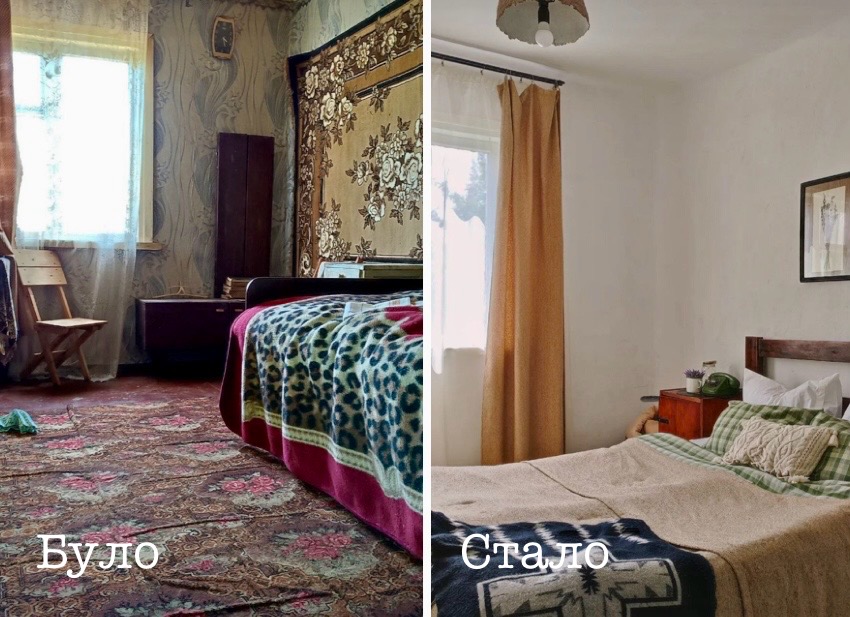
Before and after the renovation of the bedroom for Yulia's friends. Photo from Yulia Dudysheva's archive
Yulia and her friends renovated two rooms in a house with minimal expenses. They plastered and painted the walls, glued wallpaper to the floor, and lacquered it to update it. They gave old items a second life and made a chandelier from egg cartons. Curtains and blankets from second-hand stores helped refresh the interior even more.
According to Yulia, the renovation was eco-friendly and very budget-friendly. The first room cost only $64.
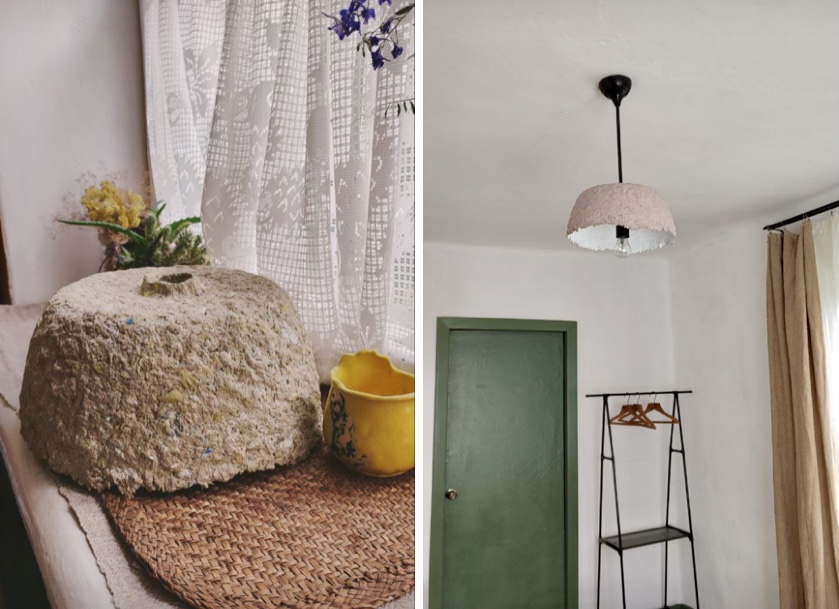
A chandelier made from egg cartons. Photo from Yulia Dudysheva's archive
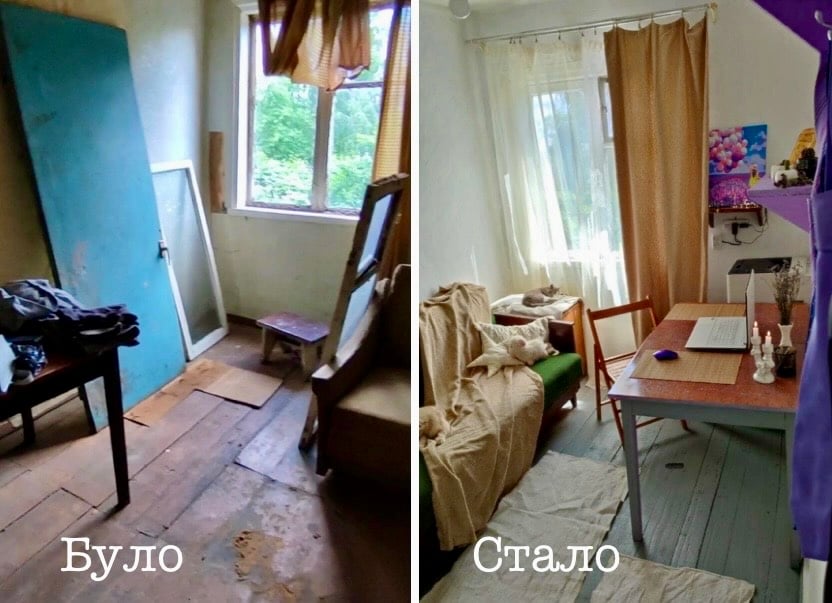
The renovation of the friends' study. The cost was about the same as the first room. Photo from Yulia Dudysheva's archive
The first success inspired Yulia. With the support of her loved ones, she started a blog and began looking for people and homes that needed transformations. This is how the "Cozy Homes for IDPs" project was born. Yulia finances the volunteer initiative through blog advertising, donations, and material help from other kind-hearted people. Often, people send Yulia used items that she restores for new owners.
Sometimes, you have to break stereotypes
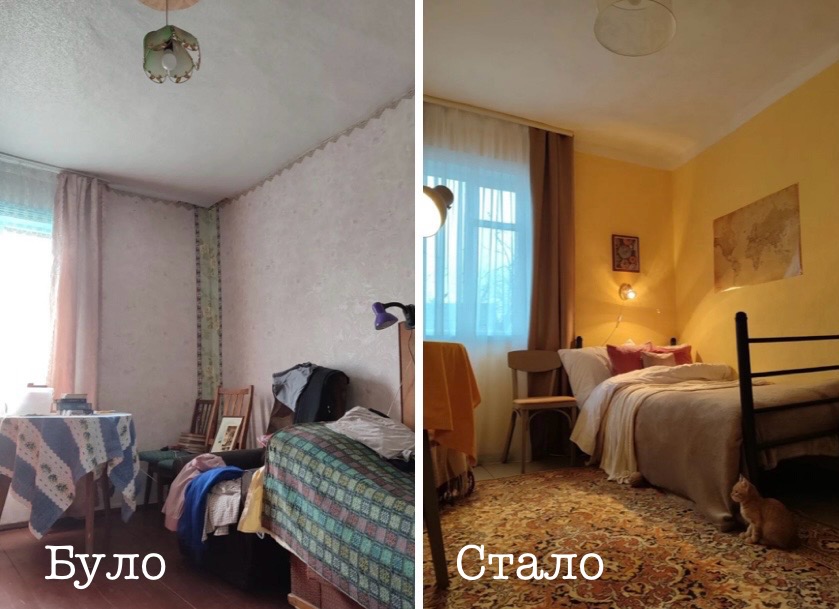
Before and after: The renovation for the couple from the war-battered area of Izium in Ukraine's northeastern Kharkiv region. Photo from Yulia Dudysheva's archive
The next transformation of the "Cozy Homes for IDPs" project was for displaced people from a village near the war-torn town of Izium. Mr. Anatolii and Mrs. Tetiana are 60 years old. Before the war, they had a lovely house, a large garden, and a farm.
"They are very hardworking people. They lived, raised two children, and were about to retire, and then… February 24," Yulia told the story of her new friends in her blog. "They were hiding in the cellar [from Russian bombing] and then realized it was time to leave. Optimistically, they removed their TV from the wall and hid it under the bed so the screen wouldn't break. They didn't take anything — any tools or equipment. They just left 'for three days.' Three days turned into three months. They lived in many places but eventually moved to Sosnytsia. Later, they found out their home was gone. They got jobs here and started from scratch."
Uncle Tolia and Aunt Tania, as Yulia Dudysheva fondly calls the couple, settled into a house where no one had lived for five years.
"It was hard for them to agree to participate in the project. They thought no one cared about them, and they believed no one needed their problems," Yulia Dudysheva shared with Rubryka. "We met and talked, and I heard just one request: 'Yulia, we don't need anything, maybe just a bed.' They were sleeping on a sofa gnawed by mice. I visited and saw there was no refrigerator or water in the house. That's how we started."
Thanks to her blog followers, Yulia, and her helpers bought a refrigerator and a washing machine and set up a water supply in the house. They purchased a wardrobe on an online marketplace and found two beds through volunteers. Some decorations and carpets came from different parts of the country and even the world. They also did decorative repairs, painted the walls, ceilings, and floors, and updated the furniture.
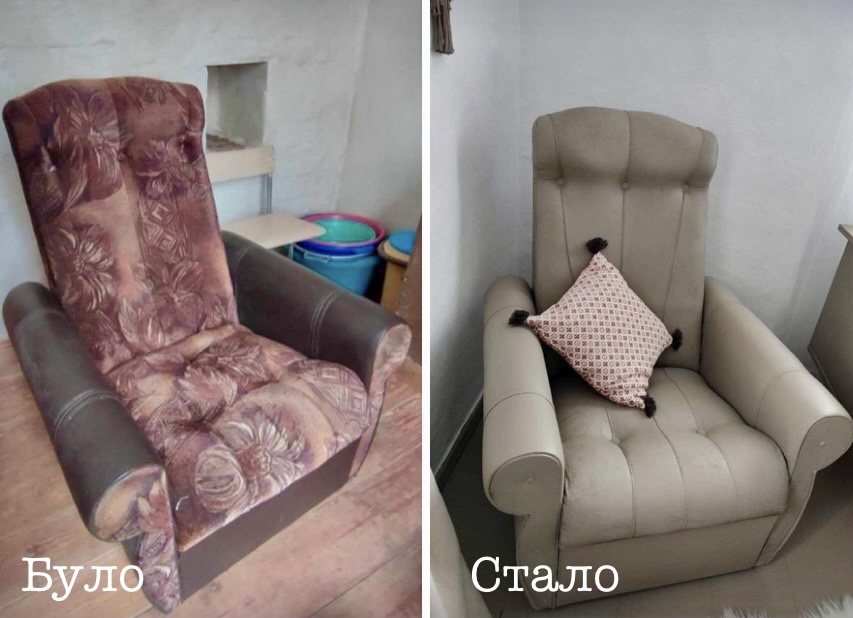
"Give her the sun, and she will paint it," said one of Yulia's followers in the comments after Yulia painted a chair in the above "Before and After" photo. Anything is possible if you know how. Photo from Yulia Dudysheva's archive
In just a month, volunteers renovated two rooms. Yulia decided to paint the walls of one room white to highlight the authenticity of the old house.
"At first, people didn't believe it would look good. People [in Ukraine] often associate white walls with the Soviet times. I only found this out after we finished. Initially, Aunt Tania said she didn't care as long as it was clean, but she was a bit disappointed with the white. We met six months later, and she said: 'I am so grateful. It's beautiful, bright, and fresh. I walk in and feel like living!'" Yulia recounts.
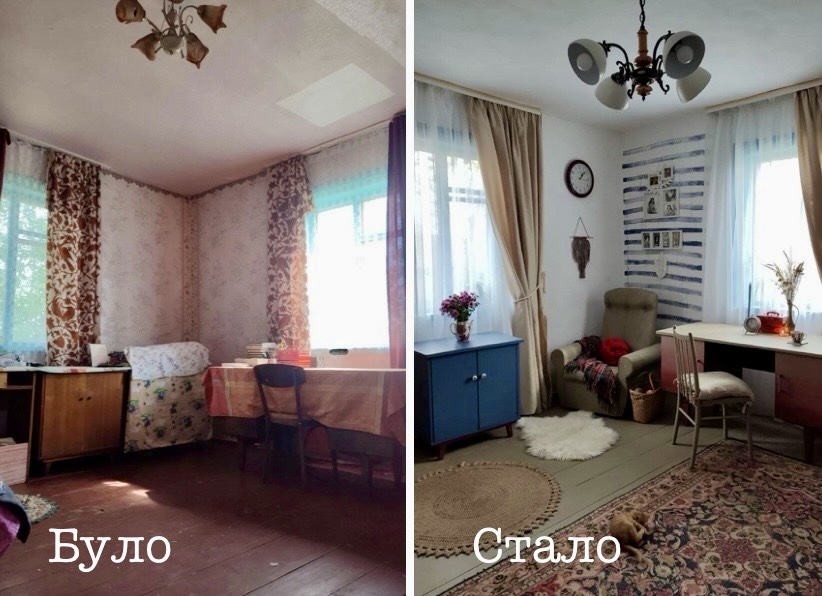
The renovated room for the displaced couple. Photo from Yulia Dudysheva's archive
A cozy interior is all about the little things and stories
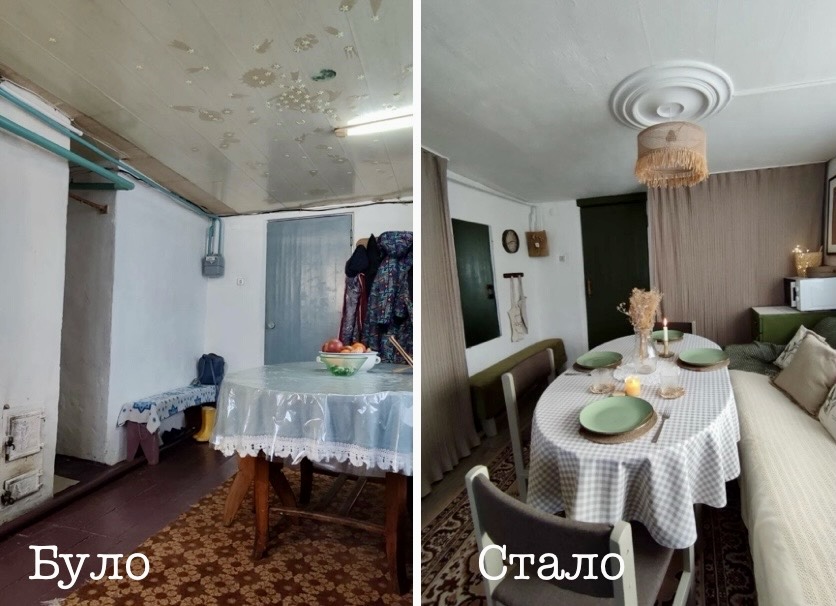
Project "Cozy Kitchen." The photo shows the "Before and After" of the kitchen renovation for people who moved from the eastern Luhansk region. Volunteer designers helped Yulia create the kitchen layouts online. Photo from Yulia Dudysheva's archive
So far, Yulia has completed five renovations for three families. She and her project demonstrate that creating coziness doesn't require a lot of money. You can restore old, discarded items, use wallpaper instead of linoleum or laminate, make wall stamps from potatoes, and decorate unattractive pipes with curtains, among other things.
Yulia believes it's not shameful to give old things a second life. She happily restores cabinets, nightstands, chairs, and tables that previously served as bug shelters.
"Old things have a lot of life, and if given a chance, they can bring more coziness. I wish people could see potential in others, just like I sometimes see it in old, worn-out furniture," says Yulia Dudysheva.
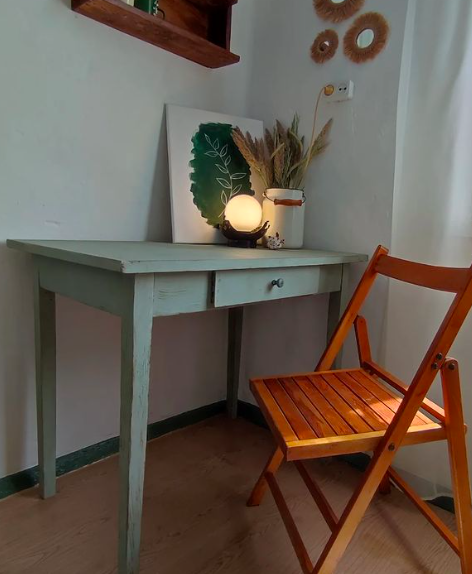
A restored table named William — Yulia often gives new names to restored items. Photo from Yulia Dudysheva's archive
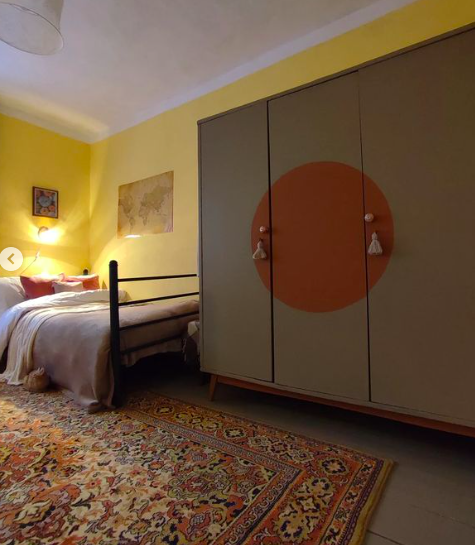
A repainted wardrobe named Winnie. Photo from Yulia Dudysheva's archive
Preserving history
Yulia also tries to preserve the history of the old houses where displaced people usually settle.
"People tell me: these walls must be covered with plasterboard and made perfectly smooth. No, these are logs, natural wood. It's a sin to cover them. You should highlight them. Many designers are now moving toward a more natural look. And here we have our native look. And that's cool; it's our past," she says.
Yulia doesn't always follow the rules; her followers often point this out. Some think the colors don't match, some are bothered by the carpets, and others find specific details inappropriate. However, Yulia takes the criticism calmly, saying, "We are creating interiors for living, not for a magazine cover."
Yulia Dudysheva believes working with your hands can support mental health and distract from difficult times.
"Sometimes people write to me that renovations make them depressed, but most of my followers say they get distracted when they paint or glue something. I feel the same. There are always things to worry about, such as family, health, friends, living 100 kilometers from the [Russian] border, and just a lot of negativity now. But when you work with your hands, there's no room for negative thoughts."






